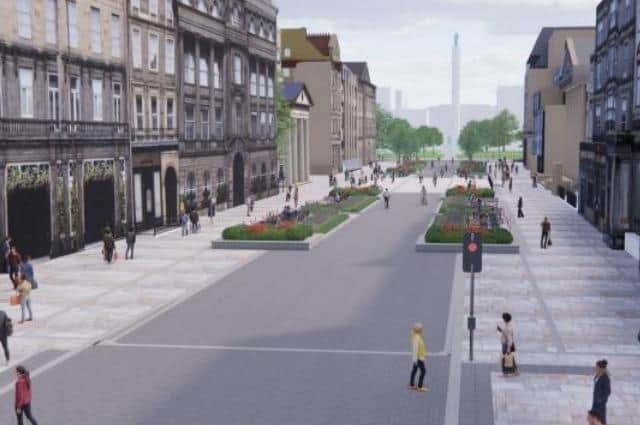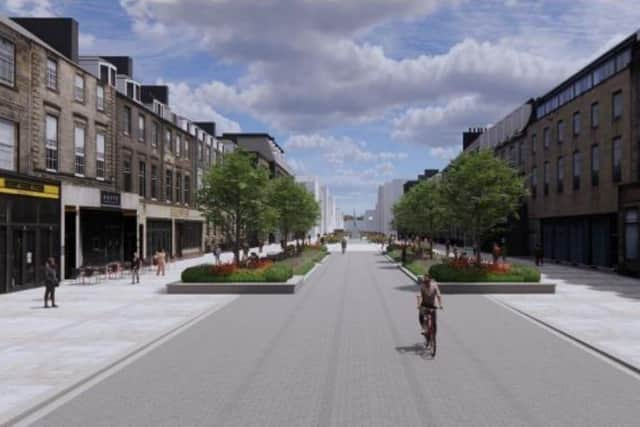Edinburgh George Street pedestrianisation: Trees to be included and increased access for disabled and taxis
and live on Freeview channel 276
Trees will be planted in Edinburgh’s George Street for the first time as part of pedestrianisation plans.
And blue badge holders and taxis will be given greater access than originally planned. The latest update on the detailed proposals for the £36 million redesign of George Street will go to the city’s transport and environment committee for approval this week. The street is set to become a pedestrian and cycling zone, with other traffic excluded, between 10am and 7pm, Monday to Saturday, and between noon and 7pm on Sundays.
Advertisement
Hide AdAdvertisement
Hide AdAnd only “permitted vehicles” – such as delivery lorries – will be able to access the street outside these times. The current parking down the centre of the street will be removed, buses will be rerouted away from George Street, the pavement will be widened and the carriageway will become a “cycle street” with vehicles treated as “guests”.


The proposal to include trees in the revamp comes after a long-running debate. Environment campaigners argued trees would help combat the effects of climate change, but heritage bodies warned they would conflict with the original design principles for the street. But a report to the transport committee says a consensus has been reached that trees can be introduced, but only at either end of the street "at this stage" in order to limit the impact on the appearance of the street.
The plan is for a total of 16 trees to be planted, eight in the blocks at each end of the street. The species of tree has yet to be decided, but one option, to have “cube-shaped” trees to reflect the nature of the street, has been ruled out . A ground-penetrating radar survey has been carried out to identify utility pipes and under-street cellars to help decide exactly where the trees can be planted.
Transport and environment convener Scott Arthur said he had chaired a workshop which included businesses, conservation groups and others looking at issues around the World Heritage Site status. He said: “We have to respect the fact that the layout of the street is structured on a very formal basis. We agreed there would be trees in the blocks at each end of George Street, all very similar, and evenly spaced, just to respect that formal nature of the street.
Advertisement
Hide AdAdvertisement
Hide Ad"People did adopt quite strongly held positions. But then we moved on to look at some of the options and some of the illustrations for the street. And I think that was the thing that actually brought people together. When they saw some of the visualisations about how it was actually going to look I think they could see it could add a bit of value.”


Disabled blue badge holders were due to be allowed to take their vehicles into George Street only outside the core 10am-7pm period, but after discussions with campaign groups the proposal has been changed to give greater access. Cllr Arthur said: “There will be quite a few blue badge spaces in the street. Now we're saying we will allow blue badge access 24 hours a day, but during the restricted period people with a blue badge will only get into the area if a blue badge space is available.” He said blue badge holders would also be able to park in the streets adjoining George Street, where mobility hubs were planned, giving disabled people access to a mobility scooter to use on George Street.
Greater access is also being proposed for taxis. Cllr Arthur said: “The other change we're making is we'll allow taxi access in the evening on the back of work we've done around women's safety in the night-time economy. We don't want this to be seen as a place where you've got to walk some distance to get a taxi and people don't feel safe.” But discussions are still going on about whether taxis being used by disabled people should be allowed onto George Street during the core 10am-7pm period.
Cllr Arthur said: “The more vehicles we let in during the restricted period, the more value we lose from it, but we do have obligations to make sure Edinburgh is an equal and accessible city.” He pointed out that taxis going to the Gyle or St James Quarter shopping centres could not take people right to the door of the shop they wanted to go to. And he said he wanted to look at how other cities operated their pedestrianised areas.
Advertisement
Hide AdAdvertisement
Hide AdIf the details proposed in the report are approved, officials will start to process the required statutory orders over next few months and technical detailed design, which is expected to take about a year, will also get under way. A public hearing is expected o be called on the scheme, which would add nine months or so to the timetable. But if things go well, the scheme could come into effect in spring 2025.
Cllr Arthur said: “It’s frustrating these things take so long. But this is a really important project, supporting both the general economy in Edinburgh but also the tourist economy. I think it's going to give it a real boost.”